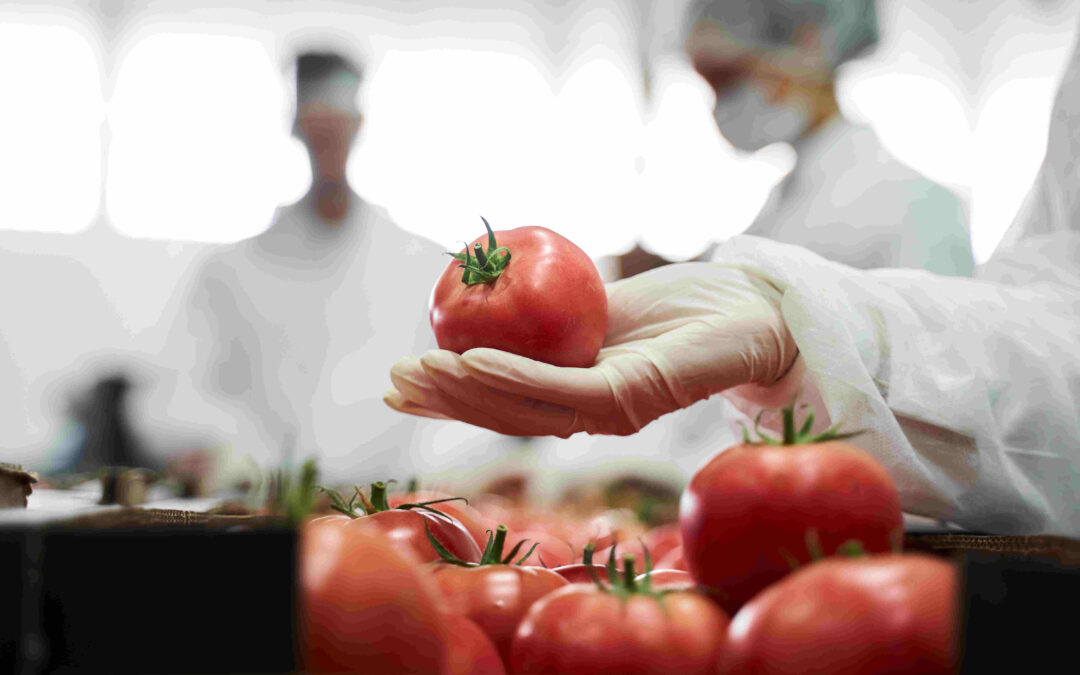Industrial and collaborative robots have been used for many years in car manufacturing and electronics. Their advantages mean that they are also increasingly used by other industries, such as the food industry.
Table of contents:
- Robotics in the food manufacturing sector
- Food processing industry – tasks carried out by robots
- Food production sector – examples of robotic applications
- Robots in the food industry. Summary
Robotics in the food manufacturing sector
The food industry is one of the largest and most profitable industries in the world. The European Union holds around 13% of the total market share. It is also estimated that the food manufacturing sector gives jobs to around 4 million people. However, this is currently a relatively poorly robotised industry.
Why is that? The reason for this may be that most food production companies are categorised as small or medium-sized enterprises. Smaller companies are concerned about the risks associated with implementing costly investments, and this certainly includes the robotisation of production.
Therefore, robotic technology innovations in the food industry are most often found in large plants of companies owned by multinationals. It is the largest players in the market that have the investment potential to increasingly use robots in food production.
However, it is probably only a matter of time before small and medium-sized companies are also robotised. The benefits of industrial and collaborative robots mean that the question is not whether smaller companies will ever decide to introduce them, but rather when it will happen.
For companies that have already recognised this some time ago, the benefits of robotisation are worth taking the risk. The most recent technological advances in robotics mean that industrial and collaborative robots are excelling in the food industry, often performing operations such as pre-packing, packaging and palletisation of finished products.
Often, robots in the food industry are also used for more delicate work, such as decorating cakes or other confectionery products or cutting raw food products into pieces or slices.
Food processing industry – tasks carried out by robots
The palletising of finished products is one of the main tasks for which robots are used by the food industry. Robots with a serial kinematic chain are usually used for this task. As there is no risk of the robot coming into contact with the unpackaged product at this stage of production, standard robot models that do not have to meet stringent cleanliness and tightness requirements can be used to palletise products.
But what about the situation in which the robot may come into contact with an unpackaged product? Food processing is an industry characterised by stringent cleanliness and hygiene requirements. Robotic technology innovations have also found their way into this area. Robot manufacturers use special coatings that allow their devices to meet all hygiene standards.
Robots used by the food industry are usually IP67 certified. It ensures that no grease or other operating fluid can escape from the robot to the outside. The airtightness also allows the robots to be cleaned quickly and effectively in accordance with the requirements of the food industry.
Operations during which the robot may come into contact with an unpackaged product are mainly picking and packing of products. Compared to palletising, food processing uses much smaller robots with lower lifting capacities but much faster working movements for these tasks.
Most commonly, these operations are performed by SCARA-type robots with a parallel kinematic chain. Robotic technology innovations also allow the most common devices with a serial design, which can also be successfully used for palletisation purposes.
Food production sector – examples of robotic applications
In addition to standard tasks such as the aforementioned palletisation and packaging, robotics in food manufacturing often includes fewer “standard” tasks. A good example of such an application could be the cutting of animal carcasses. Once they are delivered to the lines, they must be processed into a form that allows further processing. Although this is not a typical task for a robot due to the irregular shape of the carcass, the most recent technological advances have made it possible to robotise this process.
How was this process robotised? Robots are controlled with machine vision systems. The robots are equipped with tools with which they cut the carcasses or special grippers with which they simply guide the carcasses onto the saw. Where the carcass is to be cut is determined in special software that creates a model of the carcass based on camera images and determines where it is to be cut.
Another interesting example of how the food industry utilises robots is the cake decorating we mentioned earlier. This is a tedious task for a human being, which additionally requires a high degree of precision and repetition. In the case of mass-produced cakes and baked goods, they tend to have very regular shapes, which makes it easy to use the robot when decorating them.
As with carcass cutting, the robots used for food processing are also controlled by machine vision. Which attachments they are equipped with depends on what kind of topping, cream or other decoration the robot has to work with. In addition, machine vision systems in such operations are used to check the quality of the decoration. It is also important that the control software allows quick and easy modification of the decoration pattern in the event of changes made to the product.
Robots in the food industry. Summary
The food industry, like other industries, is currently investing heavily in the development of robotic solutions. Despite the fact that due to the cost of such solutions, it is mainly large companies that choose to implement them, industrial robots are slowly making their way into smaller food processing companies as well.
What makes the case for replacing conventional workstations with robotic ones? In this respect, the food industry is not much different from others. Robots allow tedious, repetitive operations to be performed with the utmost precision and repeatability. In addition, they never get tired and repeated lifting of smaller or larger weights does not affect them.
If you would like to implement a robotic application in your business or if have any doubts as to whether this type of solution will work for your business, please use the contact form on our website. Our consultants will certainly clarify all your doubts and help you choose the best solution for your company.


